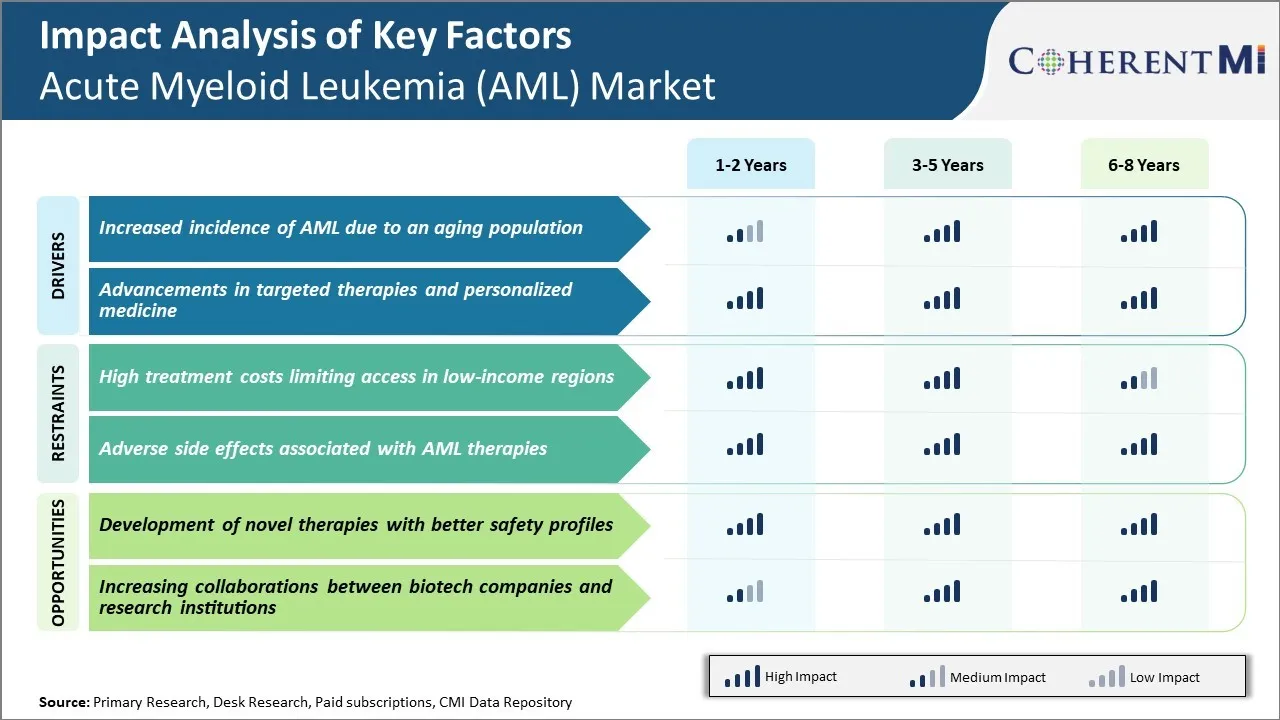Acute Myeloid Leucemia AML Market ANALISI DIMENSIONE E QUOTA - TENDENZE DI CRESCITA E PREVISIONI (2024 - 2031)
Leucemia mieloide acuta (AML) Il mercato è segmentato da Terapia (Chemoterapia, Terapia mirata, Immunoterapia), Per Strada dell'Amministrazione (Oral,....
Acute Myeloid Leucemia AML Market Tendenze
Driver di mercato - Aumento dell'incidenza di AML a causa di un'invecchiamento della popolazione
Poiché la popolazione matura in tutto il mondo, le incidenze della leucemia mieloide acuta dovrebbero aumentare sostanzialmente nei prossimi anni. È un fatto consolidato che AML colpisce gli adulti con circa il 70% dei casi diagnosticati in persone di età superiore ai 65 anni.
Si prevede che il numero di persone di età compresa tra i 65 anni o più anziani a livello globale raddoppia da livelli attuali a oltre 1,5 miliardi entro il 2050. Le persone in questa fascia d'età hanno considerevolmente maggiori probabilità di contrarre AML rispetto agli individui più giovani. Con più popolazione che entra nelle fasce di età ad alto rischio, il numero assoluto di casi AML non può rimanere invariato. Anche nei mercati sviluppati dove i sistemi sanitari sono ben attrezzati, un maggior carico di casi metterà pressione sulle risorse e sulle infrastrutture esistenti.
Declinare il sistema immunitario e aumentare la suscettibilità al danno del DNA può rendere gli anziani più inclini ai tumori del sangue come AML. Una maggiore prevalenza di comorbidità contribuisce anche ai risultati più poveri nei pazienti più anziani. Mentre gli sforzi R&D continuano a sviluppare opzioni di trattamento più sicure e più efficaci, l'aumento della popolazione geriatrica da sola garantisce un aumento dei tassi di incidenza AML in futuro.
Anche se i tassi di cura migliorano marginalmente, il picco previsto nel demografico più vecchio supererà tali guadagni, portando ad un aumento netto dei numeri di pazienti AML che richiedono cure.
Driver di mercato - Avanzamenti in terapie mirate e medicina personalizzata
Il campo oncologia ha visto la ricerca trasformativa in terapie mirate e approcci di medicina di precisione per i tumori del sangue negli ultimi dieci anni. La comprensione più sofisticata della patogenesi molecolare a livello genetico ha permesso lo sviluppo di nuovi regimi di trattamento su misura per il profilo della malattia del singolo paziente. Questo spostamento verso la cura personalizzata basata su biomarcatrice mantiene prospettive promettenti per migliorare la gestione AML.
Con l'avvento delle tecnologie di profilazione genomica, i medici sono ora in grado di identificare specifiche mutazioni genetiche e anomalie che guidano la leucemia di un paziente. Sulla base di tali intuizioni molecolari, i farmaci mirati che bloccano i percorsi patogenici critici e le proteine possono essere selezionati. Diversi agenti mirati che attaccano le mutazioni nei geni come FLT3, IDH1/2, BCL-2 hanno dimostrato risposte clinicamente significative negli studi clinici. Altre classi mirate sotto indagine includono inibitori della chinasi della tirosina, agenti ipometilanti, BCL-2 inibitori e agenti immunoterapia.
Inoltre, i progetti di prova adattativi sono sempre più utilizzati per velocizzare l'approvazione normativa delle nuove terapie dimostrate efficaci per alcuni sottoset definiti da biomarcatori. Questo consente un accesso più rapido ai trattamenti personalizzati. I regimi combinatoriali che impiegano più farmaci mirati hanno anche il potenziale per raggiungere i tassi di remissione migliorati bloccando simultaneamente più percorsi di crescita del cancro. Nel complesso, l'evoluzione tecnologica fornisce molto ottimismo per quanto riguarda i risultati migliorati, i tempi di sopravvivenza aumentati e una maggiore qualità di vita per i pazienti affetti da AML.

Sfida di mercato - costi di trattamento elevati Limitare l'accesso nelle regioni a basso reddito
A quasi 150.000 dollari per paziente negli Stati Uniti, gli alti costi del trattamento AML rappresentano una sfida significativa per l'accesso nelle regioni a basso reddito a livello globale. La maggior parte dei farmaci AML richiedono lunghi soggiorni ospedalieri per la somministrazione intensiva di chemioterapia e molti pazienti richiedono anche il trapianto di midollo osseo, aumentando ulteriormente i costi.
Nei paesi in via di sviluppo e nei mercati emergenti, i bilanci sanitari sono molto più limitati e i regimi AML standard possono superare ciò che l'assicurazione pubblica o i pagamenti extra-tasca possono sostenere. Questo crea inequità in cui i pazienti nei paesi ricchi hanno accesso ai farmaci più recenti, mentre i pazienti altrove affrontano risultati peggiori a causa solo di limitazioni finanziarie.
Affrontare questi problemi di accesso attraverso gli sforzi come i modelli di prezzi tiered o partnership con le organizzazioni sanitarie globali potrebbe contribuire ad espandere la disponibilità di nuovi agenti in regioni in cui i costi servono come barriera primaria al trattamento.
Opportunità di mercato - Sviluppo di terapie di romanzo con migliori profili di sicurezza
C'è il potenziale per nuove terapie AML non solo migliorare i tassi di sopravvivenza, ma anche affrontare alcune delle sfide associate agli effetti collaterali negativi dei regimi esistenti e problemi di tollerabilità. Le aree di esplorazione includono terapie mirate che interferiscono con specifiche vie molecolari che guidano le cellule tiepide o immunoterapie che sfruttano il proprio sistema immunitario del corpo.
Una nuova classe promettente è anticorpo farmaco coniuga che a casa payload farmaci anticancer direttamente alle cellule di leucemia. Lo sviluppo di terapie con profili di sicurezza migliorati potrebbe rendere i trattamenti più adatti per le popolazioni di pazienti più anziani o più sgombri ed evitare ricoveri per l'amministrazione della chemioterapia. Questo potrebbe ridurre il costo complessivo di assistenza, ampliando i mercati accessibili a nuovi agenti.